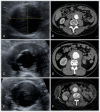Ultrasound for the Detection of Inflammatory Abdominal Aortic Aneurysms: A Case and Validation Series
- PMID: 37238153
- PMCID: PMC10216955
- DOI: 10.3390/diagnostics13101669
Ultrasound for the Detection of Inflammatory Abdominal Aortic Aneurysms: A Case and Validation Series
Abstract
Inflammatory abdominal aortic aneurysms (iAAA) are a form of noninfectious aortitis in patients with abdominal aortic aneurysms (AAA). Ultrasound could help to detect iAAA early. This retrospective observational study assessed the potential of using ultrasound to detect iAAA in a case series of iAAA patients, and the diagnostic value of ultrasound to detect iAAA in consecutive patients in a follow-up for AAA, referred to as a feasibility study. In both studies, diagnosis of iAAA was based on a cuff surrounding the aneurysm using CT (golden standard). The case series included 13 patients (age 64 (61; 72) years; 100% male). The feasibility study included 157 patients (age 75 (67; 80) years; 84% male). In the case series, all iAAA patients showed a cuff surrounding the aortic wall on ultrasound. In the feasibility study with AAA patients, ultrasound yielded no cuff in 147 (93.6%; CT negative in all cases), a typic cuff in 8 (5.1%; CT positive in all cases), and an inconclusive cuff in 2 (1.3%; CT negative in both cases) patients. Sensitivity and specificity were 100% and 98.7%, respectively. This study indicates that iAAA can be identified with ultrasound, and safely ruled out. In positive ultrasound cases, additional CT imaging might still be warranted.
Keywords: IgG4-related disease; aortitis; chronic periaortitis; inflammatory abdominal aortic aneurysm; periaortitis; retroperitoneal fibrosis; ultrasound.
Conflict of interest statement
The authors declare no conflict of interest.
Figures



References
LinkOut - more resources
Full Text Sources

